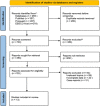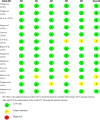The Impact of Artificial Intelligence in Improving Polyp and Adenoma Detection Rate During Colonoscopy: Systematic-Review and Meta-Analysis
- PMID: 38019222
- PMCID: PMC10772777
- DOI: 10.31557/APJCP.2023.24.11.3655
The Impact of Artificial Intelligence in Improving Polyp and Adenoma Detection Rate During Colonoscopy: Systematic-Review and Meta-Analysis
Abstract
Introduction: Colonoscopy may detect colorectal polyp and facilitate its removal in order to prevent colorectal cancer. However, substantial miss rate for colorectal adenomas detection still occurred during screening colonoscopy procedure. Nowadays, artificial intelligence (AI) have been employed in trials to improve polyp detection rate (PDR) and adenoma detection rate (ADR). Therefore, we would like to determine the impact of AI in increasing PDR and ADR.
Methods: The present study adhered to the guidelines outlined in the Preferred Reporting Items for Systematic Reviews and Meta-analyses 2020 (PRISMA 2020) statement. To identify relevant literature, comprehensive searches were conducted on major scientific databases, including Pubmed, EBSCO-host, and Proquest. The search was limited to articles published up to November 30, 2022. Inclusion criteria for the study encompassed full-text accessibility, articles written in the English language, and randomized controlled trials (RCTs) that reported both ADR and PDR values, comparing conventional diagnostic methods with AI-aided approaches. To synthesize the data, we computed the combined pooled odds ratio (OR) using a random-effects model. This model was chosen due to the expectation of considerable heterogeneity among the selected studies. To evaluate potential publication bias, the Begg's funnel diagram was employed.
Results: A total of 13 studies were included in this study. Colonoscopy with AI had significantly higher PDR compared to without AI (pooled OR 1.46, 95% CI 1.13-1.89, p = 0.003) and higher ADR (pooled OR 1.58, 95% CI 1.37-1.82, p < 0.00001). PDR analysis showed moderate heterogeneity between included studies (p = 0.004; I2=63%). Furthermore, ADR analysis showed moderate heterogeneity (p < 0.007; I2 = 57%). Additionally, the funnels plot of ADR and PDR analysis showed an asymmetry plot and low publication bias.
Conclusion: AI may improve colonoscopy result quality through improving PDR and ADR.
Keywords: Artificial intelligence; adenoma detection; colonoscopy; polyp detection.
Conflict of interest statement
None.
Figures
References
-
- Ahmad OF, Stoyanov D, Lovat LB. Barriers and Pitfalls for Artificial Intelligence in Gastroenterology: Ethical and Regulatory issues. Tech Innov Gastrointest Endosc. 2020;22:80–4.
-
- Brown Glissen JR, Mansour NM, Wang P, et al. Deep Learning Computer-aided Polyp Detection Reduces Adenoma Miss Rate: A United States Multi-center Randomized Tandem Colonoscopy Study (CADeT-CS Trial) Clin Gastroenterol Hepatol. 2022;20:1499–507. - PubMed
-
- Gerwert K, Schörner S, Großerueschkamp F, et al. Fast and label-free automated detection of microsatellite status in early colon cancer using artificial intelligence integrated infrared imaging. Eur J Cancer. 2023;182:122–31. - PubMed
-
- Gong D, Wu L, Zhang J, et al. Detection of colorectal adenomas with a real-time computer-aided system (ENDOANGEL): a randomised controlled study. Lancet Gastroenterol Hepatol. 2020;5:352–61. - PubMed
Publication types
MeSH terms
LinkOut - more resources
Full Text Sources
Medical
Research Materials







